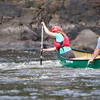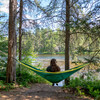
Discover the Joy of Skijoring

The first time you hear the term you’re bound to wonder: What is skijoring? In short, skijoring is cross-country skiing with your dog (or dogs) harnessed up to pull you along. Skijoring with dogs is a lot of fun, a great way for you and your four-legged friends to get some exercise and enjoy the snowy woods while developing your relationship.
Skijoring is like dogsledding but a team of dogs is simplified to one or two, and the cumbersome dogsled reduced to a pair of speedy cross-country skis. Other than cross-country skis, bindings, boots and poles, skijoring-specific gear is simple and a full kit is often available for less than $100. You will need a dogsled-style harness for your dog, a tow-line (skijor specific models have a built-in shock absorber), and a padded waist belt.
You don’t need a husky to go skijoring. If your dog is larger than 14 kg (30 pounds), well behaved and loves to run, it’s probably ready to skijor. To stay safe and maintain control over your dog, you should have at least novice cross-country skiing skills to try skijoring. Skijoring is especially fun (and fast) for those with advanced skate-skiing technique.
There are plenty of great places to try skijoring. Ontario Parks and other natural areas provide excellent locations to try it out, with several Ontario outfitters offering skijoring for beginners lessons. It’s important to note that skijoring (and dogs in general) are not allowed on all groomed cross-country ski trails, so be sure to follow the rules. Similarly, you should resist the urge to skijor on groomed snowmobile trails for safety’s sake. As with just about any pet-focused activity, you can find plenty of information and groups of like-minded people on skijoring Ontario Facebook pages.

Can you skijor with your dog?
Skijoring with dogs can be fun for just about anyone, human or canine. The first criteria for skijoring for beginners is a well-behaved, reasonably fit dog. Mid-size dogs between 18 and 27 kg (40 to 60 pounds) are the easiest to handle, but your control and safety while skijoring ultimately boils down to your relationship with your pet (how well it responds to commands) and your ability to ski.
Beginner skijorers are advised to take a few introductory cross-country ski lessons sans-Fido to get a handle on the sport. Canicross, or trail-running with your dog, is a great way to condition your dog for skijoring without the added complications of slippery skis, awkward poles and icy hard-packed snow. Be sure you’re at least a novice skier before skijoring with dogs. You should be able to control your speed on downhills, negotiate corners and handle your poles confidently before you try skijoring with dogs.
Look for gentle trails and plenty of space for your first skijoring outing, and ideally try to avoid a busy time of day. Groomed trails are ideal, but make sure that dogs are allowed. Open areas with compacted snow like city parks work well, too, along with golf courses. A wider pair of entry level cross-country skis are ideal for trying it out, and will allow you to venture into areas where the snow cover is a little deeper.
As your dog discovers the freedom of running and pulling and you progress from a novice to intermediate skier, you may wish to try skate-skiing. This high-intensity style of nordic skiing makes for exhilarating skijoring in the right conditions on groomed snow, especially if you have an athletic dog.
Best dog breeds for skijoring
Any dog over 14 kg (30 pounds) can skijor. Iconic sled dog breeds like huskies and malamutes are often great pullers and naturally equipped to stay warm outside in the cold (and also make for the best pictures), but the truth is everything from golden doodles to spaniels and mid-sized Heinz 57 mutts can learn to be great skijor dogs—because just about every dog loves to run and play in the snow.
Ultimately, the most important criteria for skijoring with dogs is a well-behaved canine companion who listens to your commands. After that, the sport is as simple as encouraging your dog to run and overcoming the annoying tendency of some animals to make sudden sniff stops. Since you’re bound to meet other humans and dogs along the trail you’ll also want a dog that’s friendly and tolerant of others.

How old does a dog have to be for skijoring?
Regardless of the breed, it’s a good idea to wait until your dog is at least a year old (some vets and dogsledders recommend 18 months) before trying him or her out in a harness to allow their muscles and bones to become fully developed. Besides growing physically, these youthful days are also the best time for your dog to learn basic obedience skills.
How many dogs do you need for skijoring?
For simplicity and control, skijoring for beginners is best with one dog. This is good advice for both the sake of humans and hounds, since more dogs increases the likelihood of tangles. As you develop your skills it’s possible to skijor with two or even three dogs. Speed increases with the number of dogs—as does the degree of difficulty in staying upright, keeping control of your poles and managing your team of dogs. If you have more than three dogs you’re best to break off into several skijoring groups or try dogsledding.
Skijoring gear
You’ll need a pair of cross-country skis, bindings, boots and poles to skijor with dogs. Your skis don’t need to be high-performance; classic touring or track skis are adequate, and fish-scale or skin (no-wax) bases are ideal for ease of maintenance and use. You can also skijor on skate-skis if you have the appropriate skills and fitness.
You will need to fit your dog with an appropriate sized dogsledding harness for pulling; do not use your dog’s collar. Harnesses are sized based on the dog’s measurements, including the length of their back and width of chest, so be sure to try before you buy. Skier and dog are tethered with a towline (approximately 3 metres in length), ideally with a section of bungee for a shock-absorber. The towline is attached to the skier at a waist belt; wider is typically better in terms of control. Depending on your dog’s breed they may benefit from a set of booties to protect their paws from slush and ice accumulation.
Harnesses, skijor towlines, waist belts and booties are available at specialty retail stores like Chaltrek in Thunder Bay, while AKKO Sports and Nahak offer online sales. You may also find harnesses and other gear at some pet stores across Ontario. Many skijorers make their own gear, including dog harnesses. Search online for plans.

How to skijor with your dog
Skijoring with dogs is a team sport and you’ll have to learn it together with your canine companion. Since most obedience training involves reprogramming your dog’s desire to run and pull and focuses on sitting, staying and heeling close, with skijoring you face the challenge of encouraging your dog to rediscover its independence—while still following your commands.
The easiest way to get started with skijoring is to recruit a friend (ideally a capable cross-country skier) to ski ahead and encourage your dog to chase, providing lots of positive reassurance and praise along the way. Start with short distances and make sure you always try to end skijoring sessions on a positive note to keep up your dog’s enthusiasm. Skijoring commands like “hike!”, “let’s go!” and “hup!” urge your dog to keep up the pace and avoid tempting smells (or other dogs) along the trail.
Skijoring commands to steer right and left are “gee” and “haw”, respectively. It takes plenty of practice to condition your dog to these instructions, and the best way is often to introduce them on leashed walks over time. Similarly, skijorers use the command “on by” to encourage their dog(s) to keep running past distractions along the trail. Again, this skill is easiest to teach on leashed walks around town. You can try to encourage your dog to slow down with a long, low “whoa”, but don’t expect to get an instant response if they’re running hard and having fun!
Always keep training sessions as positive as possible, providing lots of praise, pats and treats as rewards. Do your best to make your dog’s harness a signal of skijoring (and ideally fun), and insist they’re well-behaved and following commands whenever they are harnessed up.

Skijoring lessons
As with any skill, you’ll shorten the learning curve to proficiency by taking a skijoring lesson or two. If you’re a beginner nordic skier, it’s best to take a few introductory lessons without your dog to hone your cross-country skiing technique and make the skijoring experience safer and smoother for you and your dog.
Similarly, both you and your dog will benefit from basic obedience training before you set out on snow. If your dog is amply obedient then try a more advanced class in agility to work on your pet’s independence, a critical trait for skijoring. Once you’re ready for a snowy adventure, options for Ontario skijoring lessons include the following:
Yours Outdoors, Haliburton
Yours Outdoors offers comprehensive skijoring lessons in Ontario’s Haliburton region in January and February. Participants work with veteran competitor and instructor Karen Koehler to fast-track their skijoring skills. Level 1 training is a perfect introduction to skijoring for beginners with novice nordic skiing experience and a dog who loves to pull. Level 2 focuses on more advanced skills to develop your proficiency.
Happy Tails, Muskoka
Happy Tails offers beginner skijoring lessons in Huntsville all winter long. Private and small-group instruction is available, depending on your experience and ambitions. Happy Tails also offers intermediate lessons to develop specific skills and a full-day skijoring workshop to fast-track your development.
Thunder Bay Skijoring
Thunder Bay has an active snow sports scene with a lengthy winter season—and plenty of options for adventure. For beginner skijoring check out the Thunder Bay Skijoring Facebook group for basic lessons, gear advice and general tips.
Recommended Articles

Urban Paddling

Need solitude?

Love canoes?

"how to" video

Get Hooked in Algonquin

Want a romantic getaway?

Want to get off the beaten path?

Want a perfect weekend getaway?

Video

Best Outdoor Adventure Locations in Ontario

Insider’s Guide to Neys

11 Things You Didn’t Know About Dogsledding

Beat the Lines: Tips for 2025 Reservations
After the Storm

Dog Sledding in Ontario

Treetop Trekking

The Best Killarney Hikes

Dog-Friendly Campgrounds in Ontario




















